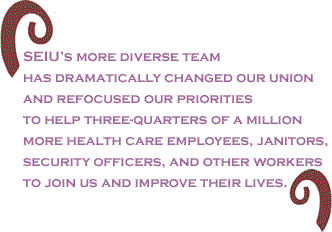
|
|||||||||||||||||||||
 |
Mr. Hudson is Executive Vice President, Service Employees International Union (SEIU) I was glad to see The Black Commentator covering the historic debate going on in the nation’s unions about how to rebuild workers’ strength in America (February 3, 2005 “Black Unionists Warn ‘Don’t Restructure Us Out’”). Your editorial was correct in advocating that meaningful changes in the union movement must involve people of color in the process and result in greater empowerment at the local level. But the commentary was not correct in its characterization of that debate, nor its description of the role of the Service Employees International Union (SEIU), which with 1.8 million members the AFL-CIO’s largest and fastest growing union. I have been active all my life both in the movement for black empowerment and in the union movement. I served as an elected executive vice president of 1199, the health care union that has been one of the leading examples of progressive unionism in the United States and is now the largest local affiliate of SEIU.
I share Black Commentator’s concern that labor has often not done enough to include people of color in its leadership at all levels, and I agree that the union movement cannot help millions more workers organize and challenge the corporate agenda in America unless it empowers Black, Latino, and Asian-American workers and communities. But that is exactly what SEIU has been doing and what its proposal, Unite To Win, is designed to bring about. Most people of color in America are facing a deepening crisis with regard to jobs, wages, health care, education, housing, and other living standards – a crisis made worse by policies of global corporations and their political allies. We cannot expect to fight back effectively as long as the union movement continues to decline in size, strength, and vitality. In the 1950s, when the AFL-CIO was founded, 1 in 3 workers had a union. Today, it is down to 1 in 12 in the private sector, and falling further every year. The percentage of workers who have a union has declined in virtually every industry, to the point that increasingly it is nonunion companies’ low wages and lack of benefits that set the standard in our economy instead of union employers. To make matters worse, the sectors that are growing – especially the huge, expanding service sector led by Wal-Mart – are almost entirely nonunion and follow a business model of low wages and few benefits, while what union membership remains is concentrated in industries that are declining in employment. SEIU’s Unite To Win proposal calls for dramatic changes in labor’s strategy, priorities, culture, and structure to once again give working people a fighting chance: 1. Every worker would have the right to belong to a union that unites all workers in his or her industry or sector – instead of the current situation where labor’s traditions keep transportation workers divided into 15 different unions, construction workers divided into another 15, and so on through each sector of the economy. Employers increasingly are regional, national, or global – but labor’s balkanized structure often keeps workers from developing strategies that match the corporations they deal with. At best, this means workers’ strength is divided. At worst, it means unions often see each other as competitors and work at cross purposes. More people are flying on airplanes in America today than before September 11th happened. Yet, many airline workers are losing their pensions, health care, and a quarter or even a third of their wages. Incredibly, there is no strategy that unites the strength of all airline workers, backed by the entire union movement. Workers at each airline are divided into many different unions, and even people who do the same job are not in the same union from airline to airline. The same problem hurts workers in my own industry. As the son of a nursing home worker and a former nursing home worker myself, I am in charge of SEIU’s long-term care sector. Our mission is to unite millions of nursing home workers and home care workers - many of them women and people of color - to fight for themselves and the communities they provide care for. We have learned that it is extremely difficult to help workers organize and win improvements at one nursing home at a time. We have to deal with large national and regional chains. We have to raise pay and benefits in whole states at a time so unionized companies will be able to compete for business. We also have to work with employers to win adequate state and federal funding that will support quality jobs and quality care. Strategies like that work best if we can unite the strength of all the nursing home workers in that state, chain, or market. Yet, we find that when we are working that strategy, it is not unusual that locals of another union will conspire with individual employers to divide the workers and saddle them with lower wages than the standard we have established. Current AFL-CIO rules do nothing to stop that, and that has to change. 2. Members’ money and time would be concentrated on helping millions more workers join in each industry, instead of on maintaining the current bureaucracy. We have proposed to cut in half the money that flows to the national AFL-CIO and instead use it for specific strategic plans to unite millions more workers in each industry and build workers’ strength. Each national and local union would also reorder its priorities to contribute more to rebuilding workers’ strength in numbers. 3. The role of local labor councils would be strengthened. Each council would develop and be held accountable to a strategic plan for building community alliances and coordinating political action to support national strategies to build workers’ strength in each industry. Local labor bodies - which sometimes divide workers in the same metropolitan area into many separate councils - would be restructured to unite workers’ strength in the appropriate area and media market.
4. For the first time, clear standards and accountability would be established for full participation at all levels of the union movement regardless of the color of your skin, the language that you speak, or your age, gender, ethnicity, sexual orientation, disability, or immigration status. We need leaders and activists at all levels of the union movement who reflect the membership in terms of race, gender, and other factors. We also need leaders who are as committed to new strategies to build new strength as the membership is. As a result of a conscious policy, SEIU’s international executive board today is 40 percent female and 33 percent people of color – not good enough yet, but significant progress nonetheless. It is no accident that SEIU’s more diverse team has dramatically changed our union and refocused our priorities to help three-quarters of a million more health care employees, janitors, security officers, and other workers – many of them women and people of color – to join us and improve their lives. There is more to SEIU’s Unite To Win proposal than there is space for here, and I invite readers to review the complete text at UniteToWin.org, where you will also find proposals from other unions and local labor councils, plus a blog where you can add your own comments. The outcome of the debate about labor’s future is far from certain. But no matter how it turns out, SEIU members are committed to working with allies across the nation and around the world to rebuild the strength of working people, give our families new hope, and empower our communities. |
| February 24 2005 Issue 127 |
|||||||||
|
|||||||||
|
|
|||||||||
| Printer Friendly Version | |||||||||
 |
|||||||||
 |
|||||||||
| |
|||||||||
| |
|||||||||


























